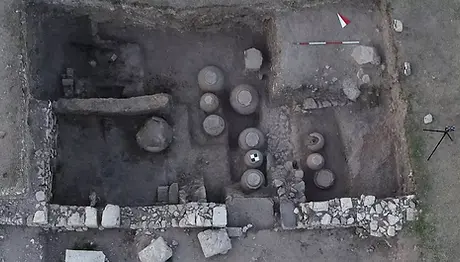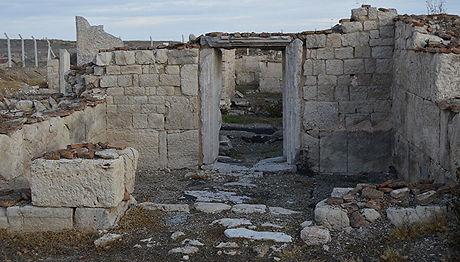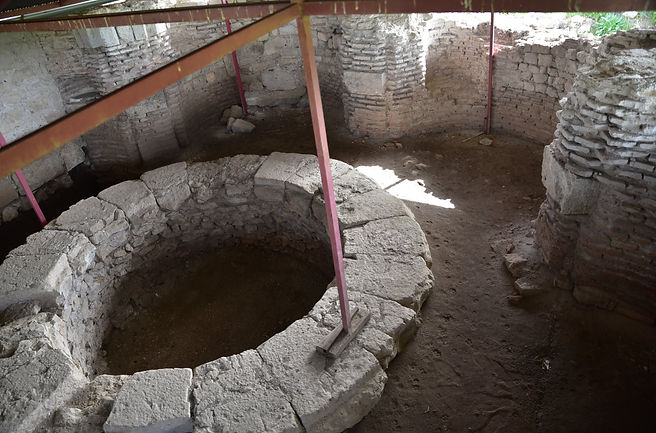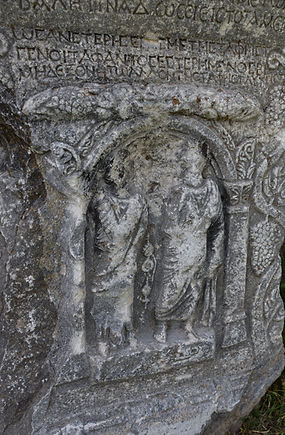

AMORIUM
Amorium Ancient City / Afyon Province / Turkey
Amorium was a city in Phrygia, Asia Minor which was founded in the Hellenistic period, flourished under the Byzantine Empire, and declined after the Arab sack of 838. It was situated on the Byzantine military road from Constantinople to Cilicia. Its ruins and höyük ('mound, tumulus') are located under and around the modern village of Hisarköy, 13 kilometers east of the district center, Emirdağ, Afyonkarahisar Province, Turkey.
Amorium is the Latinized version of its original Greek name Amorion . Arab/Islamic sources refer to the city as ʿAmmūriye. Under Ottoman rule the site, which never regained importance, was called Hergen Kale or Hergen Kaleh.

The city minted its own coins beginning between 133 BC to 27 BC until the 3rd century AD, indicating its maturity as a settlement and military importance during the pre-Byzantine period. Amorium then must have been prestigious and prosperous. But early historical records that mention the city are strictly limited to a reference by Strabo, although it is expected that new discoveries will shed light on the city's Roman period and before.

Byzantine period
The city was fortified by the emperor Zeno in the 5th century, but did not rise to prominence until the 7th century. Its strategic location in central Asia Minor made the city a vital stronghold against the armies of the Umayyad Caliphate following the Muslim conquest of the Levant.
The city was first attacked by Muawiyah I in 646. It capitulated to ‘Abd ar-Rahman ibn Khalid in 666 and was occupied by Yazid I in 669, then retaken by Constans II's general Andreas.
Over the next two centuries, it remained a frequent target of Muslim raids into Asia Minor, especially during the great sieges of 716 and 796. It became capital of the thema of Anatolikon soon after. In 742-743, it was the main base of Emperor Constantine V against the usurper Artabasdos, and in 820, an Amorian, Michael II, ascended the Byzantine throne, establishing the Amorian dynasty. This began the period of the city's greatest prosperity, when it became the largest city in Asia Minor. Its status however as the native city of the reigning dynasty also spelled its doom: in 838, the Caliph Al-Mu'tasim launched a campaign specifically against the city, which was captured and razed, an episode recounted in a poem of Abu Tammam.
The town was rebuilt, but was burned by Thamal al-Dulafi in 931. Nonetheless, it remained an active Byzantine city at least into the 11th century. Following the Battle of Manzikert, it was devastated by the Seljuks and a large proportion of its inhabitants were killed. Emperor Alexios I Komnenos defeated the Seljuks at Amorium in 1116.
It remained an important place in the 12th–14th centuries according to al-Idrisi and Hamdallah Mustawfi.

Miniature from the Madrid Skylitzes depicting the Arab siege of Amorium

Emperor Theophilos flees after the Battle of Anzen, miniature from the Madrid Skylitzes manuscript.
The 42 Martyrs of Amorium;
The 42 Martyrs of Amorium were a group of Byzantine senior officials taken prisoner by the Abbasid Caliphate in the Sack of Amorium in 838 and executed in 845, after refusing to convert to Islam. They are commemorated by the Roman Catholic Church and the Eastern Orthodox Church on March 6.
In 838, the Abbasid caliph al-Mu'tasim(r. 833–842) led a major campaign against the Byzantine Empire that ended in the sack of the city of Amorium, the capital of the Anatolic Theme and birthplace of the reigning Byzantine Amorian dynasty.
Following the sack, 42 officers and notables of Amorium were taken as hostages to Samarra, then the capital of the Abbasid Caliphate. Repeated efforts by Emperor Theophilos and, after his death in 842, by Michael III and Empress-regent Theodora, to ransom them were rebuffed by the caliphs. After refusing to convert to Islam, they were executed at Samarra on 6 March 845. Only a few of the 42 are known by name:

Ninth-century Byzantine granary found in the 2020 excavations

Byzantine rare sword that has been found during excavations
Bishopric
Amorium was a bishopric at latest by 431, when its bishop, Abraham or Ablabius, was at the Council of Ephesus. The acts of the earlier First Council of Constantinople (381) were signed by a priest, Tyrannus, of Amorium. Other bishops were Mysterius, who took part in the Council of Chalcedon in 451, Theodorus, in the Trullan Council of 692, Theodosius, in the Second Council of Nicaea in 787, and Bessarion in the Council of Constantinople (879). Theophilus was part of the mission that Photius sent to Rome about 20 years earlier.
In the Notitiae Episcopatuum of Pseudo-Epiphanius (c. 640), Amorium appears as a suffragan of Pessinus, capital of Galatia Salutaris. It appears with the same rank in another of the end of the 8th century. Soon afterwards, presumably as a result of citizens of Amorium taking the imperial throne, it became a metropolitan see with, as shown by the early 10th-century Notitiae Episcopatuum of Leo VI the Wise, five suffragan sees: Philomelium, Claneus, Docimium, Polybotus. and Pissia. There is no longer any mention of the see in the 14th-century Notitiae Episcopatuum.
No longer a residential bishopric, Amorium is today listed by the Catholic Church as a titular see.



Seljuk Era bakery

Reliefs
Click on the pic. to zoom in





